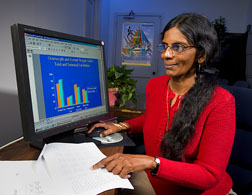|
Read the
magazine
story to find out more. |
|

Nutritionist
Shanthy Bowman compares total and saturated fat intakes of overweight and
normal-weight adults. Click the image for more information about
it.
|
Lifestyle Factors Play Key Role in Weight
Control
By Rosalie Marion Bliss
March 29, 2006
It’s no surprise that watching hours of TV and not exercising
have been linked to being overweight. Now, a study led by Agricultural Research
Service (ARS) nutritionist
Shanthy
A. Bowman provides data that will give couch potatoes a reason to get up
and get moving. She found that adults who watched more than two hours of TV on
both of two survey days were about twice as likely to be overweight as adults
who didn't watch TV on both survey days.
Bowman is with the ARS
Community
Nutrition Research Group, part of the ARS
Beltsville
(Md.) Human Nutrition Research Center. The study was described in a chapter
she authored in a book titled Body Mass Index: New Research, published
by Nova Science Publishers. The chapter
is called “Dietary and Lifestyle Practices of Normal Weight and Overweight
U.S. Adults.”
Bowman analyzed dietary intake data obtained from more than 8,500
adults through USDA’s national nutrition monitoring system over the years
from 1994 to 1996. The survey data were collected by ARS interviewers on two
nonconsecutive days.
Overall, overweight adults—as compared to normal-weight
adults—not only consumed about 100 more calories a day, but also ate most
of those extra calories at supper time.
The study also showed that adults who skipped breakfast compensated
for the energy shortfall by eating foods high in fat and/or added sugar
throughout the rest of the day.
Another trend noted in the study is also of concern. Nearly 60
percent—a relatively high percentage—of the overweight adults
identified in the study did not always remove the skin when they ate chicken.
Nutritionists recommend removing skin from chicken to reduce fat intake without
compromising the nutritional quality of the meat.
Read more
about these findings in Agricultural Research magazine’s March 2006
issue, which focuses on ARS obesity research.
ARS is the U.S. Department of
Agriculture’s chief scientific research agency.